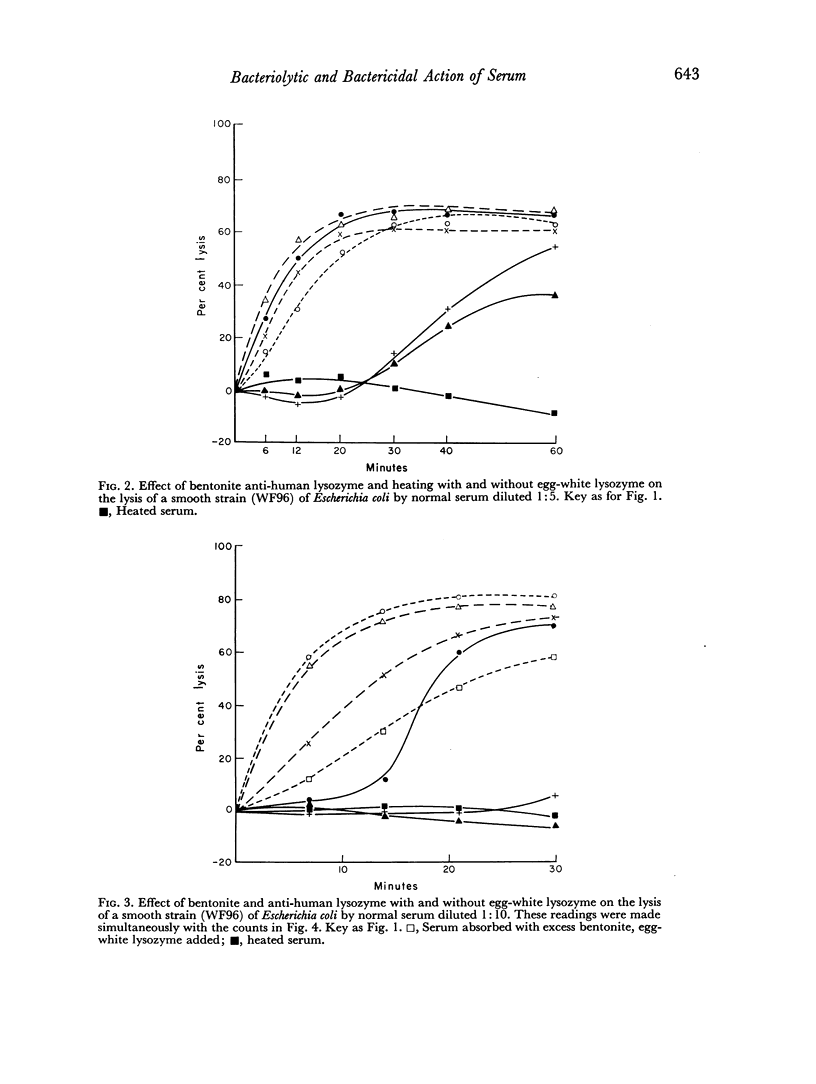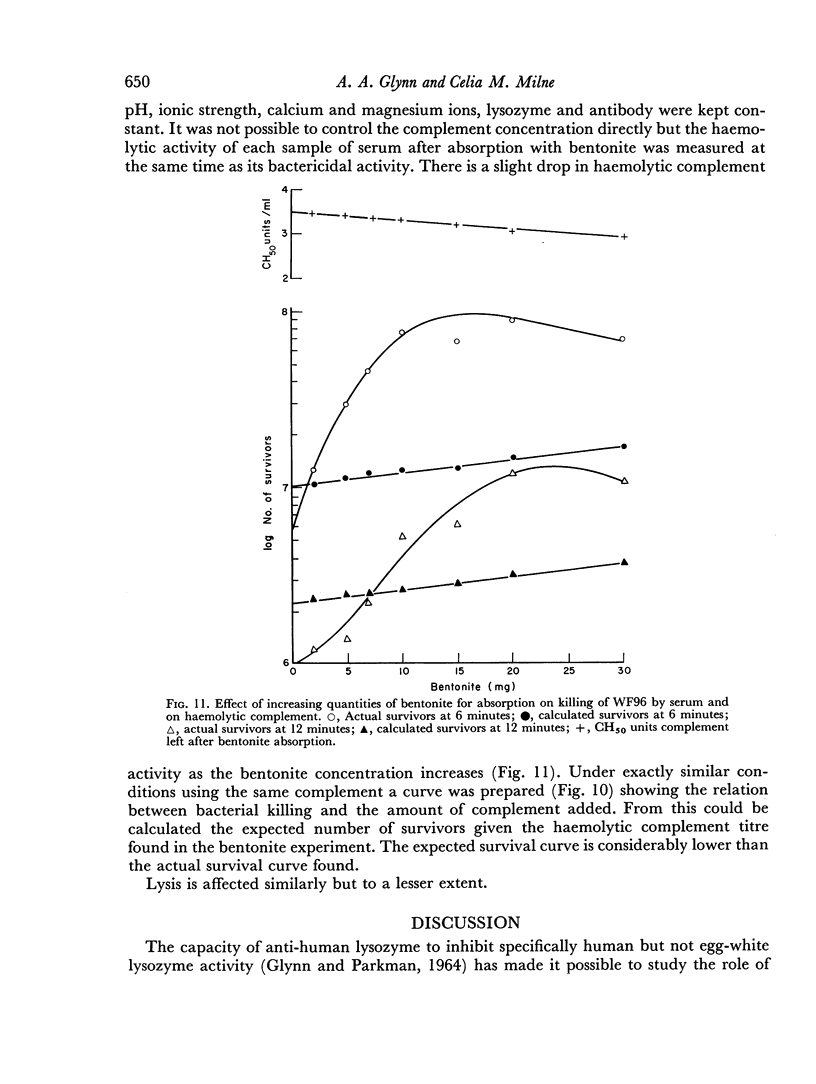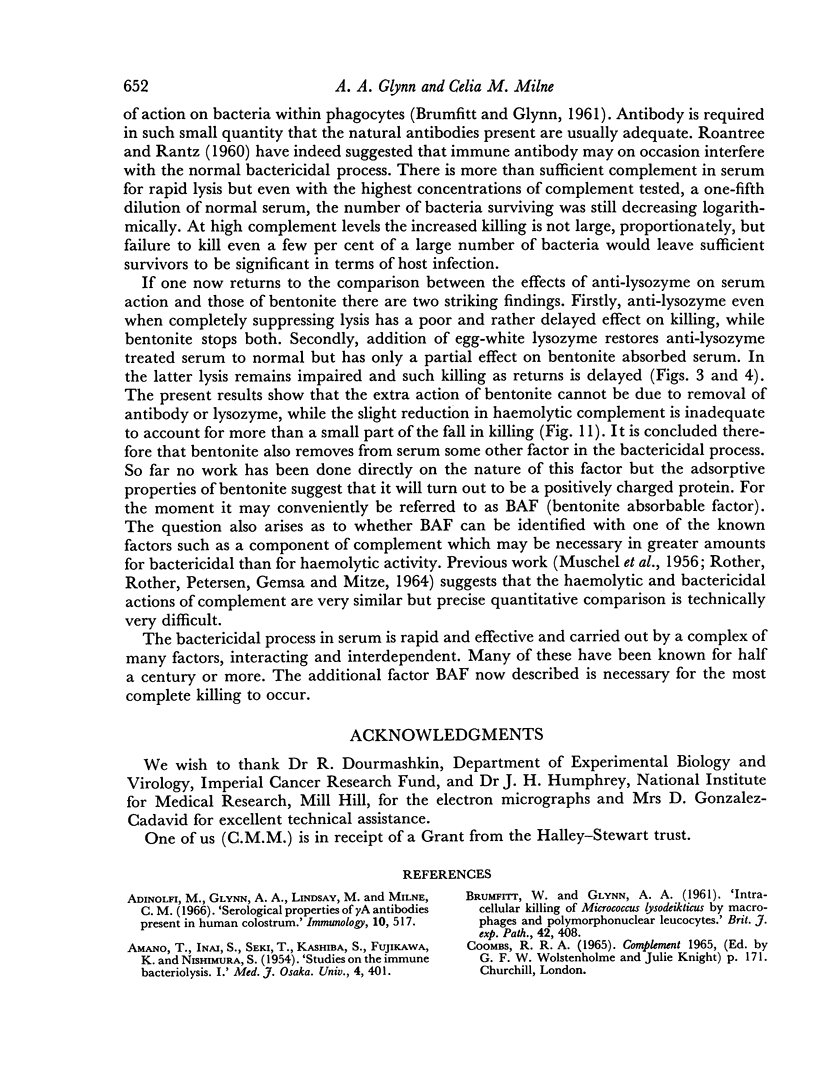Abstract
The killing and lysis of Escherichia coli by human serum have been measured simultaneously at frequent intervals for periods of 30–60 minutes. The kinetic effects of varying the amounts of lysozyme, antibacterial antibody and complement have been studied.
The rate of lysis is largely controlled by the lysozyme concentration but complement is also necessary. Killing is closely related to complement concentration. Antibody is needed in such small amounts that it is rarely a limiting factor.
Inhibition of serum lysozyme by anti-human lysozyme prevents lysis and reduces killing but both are restored to normal by addition of egg-white lysozyme. Both lysis and killing are stopped by bentonite absorption of serum and complete return to normal is not attained by subsequent addition of egg-white lysozyme. In a lysozyme-free system lysis does occur after some delay probably due to the action of complement and antibody alone.
In the presence of adequate complement and antibody the loss of complement (measured haemolytically) in bentonite treated serum is inadequate to account for the fall in bactericidal activity. A new bentonite absorbable factor (BAF) essential for complete serum bactericidal power is postulated.
Full text
PDF















Images in this article
Selected References
These references are in PubMed. This may not be the complete list of references from this article.
- Adinolfi M., Glynn A. A., Lindsay M., Milne C. M. Serological properties of gamma-A antibodies to Escherichia coli present in human colostrum. Immunology. 1966 Jun;10(6):517–526. [PMC free article] [PubMed] [Google Scholar]
- DAVIS S. D., WEDGWOOD R. J. KINETICS OF THE BACTERICIDAL ACTION OF NORMAL SERUM ON GRAM-NEGATIVE BACTERIA. J Immunol. 1965 Jul;95:75–79. [PubMed] [Google Scholar]
- Davis S. D., Gemsa D., Wedgwood R. J. Kinetics of the transformation of Gram-negative rods to spheroplasts and ghosts by serum. J Immunol. 1966 Apr;96(4):570–577. [PubMed] [Google Scholar]
- GLYNN A. A., PARKMAN R. STUDIES WITH AN ANTIBODY TO RAT LYSOZYME. Immunology. 1964 Nov;7:724–729. [PMC free article] [PubMed] [Google Scholar]
- GORRILL R. H., NEEDS D. A. A simple apparatus for shaking bacterial cultures. J Clin Pathol. 1958 Jan;11(1):89–92. doi: 10.1136/jcp.11.1.89. [DOI] [PMC free article] [PubMed] [Google Scholar]
- Gemsa D., Davis S. D., Wedgwood R. J. Lysozyme and serum bactericidal action. Nature. 1966 May 28;210(5039):950–951. doi: 10.1038/210950a0. [DOI] [PubMed] [Google Scholar]
- Glynn A. A., Milne C. M. Lysozyme and immune bacteriolysis. Nature. 1965 Sep 18;207(5003):1309–1310. doi: 10.1038/2071309a0. [DOI] [PubMed] [Google Scholar]
- MICHAEL J. G., WHITBY J. L., LANDY M. Studies on natural antibodies to gram-negative bacteria. J Exp Med. 1962 Jan 1;115:131–146. doi: 10.1084/jem.115.1.131. [DOI] [PMC free article] [PubMed] [Google Scholar]
- MUSCHEL L. H., CAREY W. F., BARON L. S. Formation of bacterial protoplasts by serum components. J Immunol. 1959 Jan;82(1):38–42. [PubMed] [Google Scholar]
- REPASKE R. Lysis of gram-negative organisms and the role of versene. Biochim Biophys Acta. 1958 Nov;30(2):225–232. doi: 10.1016/0006-3002(58)90044-1. [DOI] [PubMed] [Google Scholar]
- ROTHER K., ROTHER U., PETERSEN K. F., GEMSA D., MITZE F. IMMUNE BACTERICIDAL ACTIVITY OF COMPLEMENT. SEPARATION AND DESCRIPTION OF INTERMEDIATE STEPS. J Immunol. 1964 Aug;93:319–330. [PubMed] [Google Scholar]
- Roantree R. J., Rantz L. A. A STUDY OF THE RELATIONSHIP OF THE NORMAL BACTERICIDAL ACTIVITY OF HUMAN SERUM TO BACTERIAL INFECTION. J Clin Invest. 1960 Jan;39(1):72–81. doi: 10.1172/JCI104029. [DOI] [PMC free article] [PubMed] [Google Scholar]
- Rosse W. F., Dourmashkin R., Humphrey J. H. Immune lysis of normal human and paroxysmal nocturnal hemoglobinuria (PNH) red blood cells. 3. The membrane defects caused by complement lysis. J Exp Med. 1966 Jun 1;123(6):969–984. doi: 10.1084/jem.123.6.969. [DOI] [PMC free article] [PubMed] [Google Scholar]
- Rowley D., Thöni M., Isliker H. Opsonic requirements for bacterial phagocytosis. Nature. 1965 Jul 10;207(993):210–211. doi: 10.1038/207210a0. [DOI] [PubMed] [Google Scholar]
- WARDLAW A. C. The complement-dependent bacteriolytic activity of normal human serum. I. The effect of pH and ionic strength and the role of lysozyme. J Exp Med. 1962 Jun 1;115:1231–1249. doi: 10.1084/jem.115.6.1231. [DOI] [PMC free article] [PubMed] [Google Scholar]



